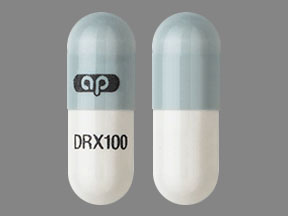
Droxidopa Coupons & Savings Card – Discount Prices from $83.70
Generic for: Northera
My prescription
Edit
100MG, Droxidopa (90 Capsules)
Select pharmacy

CVS
$2543.91
COUPON PRICE
Walgreens
$83.70
COUPON PRICE
Albertsons
$104.35
COUPON PRICE
Walmart
$116.11
COUPON PRICEDroxidopa savings card
Show this card to your pharmacist
Walgreens
$83.70
BIN
ID
PCN
GRP
019876
LH14CF0AE0
CHIPPO
LHX
Powered by
Related catecholamines prescriptions
Related catecholamines prescriptions
Droxidopa dosage forms
Dosage Quantity Price from Per unit 100MG 90 Capsules $83.70 $0.93 200MG 90 Capsules $146.70 $1.63 300MG 90 Capsules $218.70 $2.43
| Dosage | Quantity | Price from | Per unit |
|---|---|---|---|
| 100MG | 90 Capsules | $83.70 | $0.93 |
| 200MG | 90 Capsules | $146.70 | $1.63 |
| 300MG | 90 Capsules | $218.70 | $2.43 |
Droxidopa Warnings
This medication, droxidopa (Northera), comes with several important safety precautions and risks that should be carefully considered. Please review these warnings and consult your healthcare provider if you have any concerns or questions.
Supine Hypertension: This medication can lead to a significant increase in blood pressure when you are lying down. To minimize this risk, avoid taking droxidopa while lying down and consider elevating the head of your bed. Your healthcare provider will monitor your blood pressure in this position, especially after any dosage changes. If supine hypertension cannot be controlled, it may lead to serious health issues such as stroke, heart attack, or even death. In such cases, your doctor may adjust or discontinue the medication.
Neuroleptic Malignant Syndrome-like Symptoms: Rarely, individuals taking droxidopa may experience symptoms similar to neuroleptic malignant syndrome, which include high fever, muscle rigidity, involuntary movements, and confusion. These symptoms should be closely monitored, especially after a change in dosage. Seek immediate medical attention if these symptoms occur.
Heart Conditions: Droxidopa may exacerbate certain heart conditions, such as heart disease, heart failure, and heart rhythm irregularities. It is crucial to inform your healthcare provider of any existing heart conditions before starting treatment with this medication.
Severe Allergic Reactions: Allergic reactions to droxidopa can occur, with some being life-threatening, such as anaphylaxis. Additionally, some formulations of droxidopa contain Yellow No. 5 (tartrazine), which can cause respiratory issues in susceptible individuals. If you experience symptoms like a rash, difficulty breathing, or swelling of the face, tongue, or throat, seek medical help immediately.
Always discuss any pre-existing conditions and your complete medical history with your healthcare provider before starting treatment with droxidopa. In case of an overdose or severe reaction, seek emergency medical assistance promptly.
Droxidopa Side Effects
Common side effects:
- headaches
- dizziness
- nausea
Less common but important to monitor:
- vomiting
- diarrhea
- stomach pain
- chest pain
- tiredness
- blurred vision
Serious side effects:
- rash
- itching
- swelling of the face, tongue, or throat
- trouble breathing
- neuroleptic malignant syndrome (NMS)
Droxidopa Interactions
When taking droxidopa, it's important to be aware of potential interactions with other medications, as these can affect its effectiveness or increase the risk of side effects. Here are some key interactions to consider:
Medications That Raise Blood Pressure: Combining droxidopa with other drugs that increase blood pressure, such as norepinephrine, ephedrine, Midodrine, or triptans (commonly used for migraines), can heighten the risk of supine hypertension—a condition where blood pressure rises significantly when lying down. This can lead to serious cardiovascular events if not properly managed. Therefore, it's advisable to avoid using these medications together unless specifically directed by your healthcare provider.
Dopa-Decarboxylase Inhibitors: Drugs like Carbidopa, used in Parkinson's disease treatment, can interfere with the conversion of droxidopa to norepinephrine outside the central nervous system. This interaction may require adjustments to your droxidopa dosage to maintain its effectiveness.
Non-Selective Monoamine Oxidase (MAO) Inhibitors: Medications such as phenelzine, Tranylcypromine, and Linezolid can potentially cause a significant increase in blood pressure when taken with droxidopa. It's recommended to avoid combining these drugs. However, selective MAO-B inhibitors like Rasagiline or Selegiline were permitted in clinical trials with droxidopa, suggesting they may be used together under medical supervision.
Over-the-Counter Decongestants: Common cold and allergy medications containing pseudoephedrine or phenylephrine can amplify droxidopa's blood pressure-raising effects. Consult your healthcare provider before using these over-the-counter products to prevent potential complications.
Beta Blockers: Medications such as Propranolol may counteract droxidopa's ability to regulate blood pressure and heart rate, potentially reducing its therapeutic benefits. Your healthcare provider may need to adjust the dosage or explore alternative treatment options in such cases.
Dopamine Antagonists: Drugs like Metoclopramide may interfere with droxidopa's mechanism of action, potentially diminishing its effectiveness in managing symptoms of neurogenic orthostatic hypotension.
Other Antihypertensives: When droxidopa is combined with medications that lower blood pressure, careful monitoring is essential to prevent excessive fluctuations in blood pressure. Regular follow-ups with your healthcare provider are critical to ensure safe and effective treatment.
To minimize the risk of harmful interactions, always inform your healthcare provider about all prescription and over-the-counter medications, supplements, and herbal products you are currently taking. This comprehensive disclosure will help your provider manage your treatment plan effectively and safely.
